Android 16 mang đến cho nhà phát triển các tính năng và API mới tuyệt vời. Các phần sau đây tóm tắt những tính năng này để giúp bạn làm quen với các API liên quan.
Để biết danh sách chi tiết về các API mới, đã được sửa đổi, cũng như đã bị xoá, hãy đọc báo cáo điểm khác biệt về API. Để biết thông tin chi tiết về các API mới, hãy truy cập vào tài liệu tham khảo về API cho Android (các API mới được trình bày nổi bật).Bạn cũng nên xem xét những khía cạnh mà các thay đổi của nền tảng có thể ảnh hưởng đến ứng dụng của bạn. Để biết thêm thông tin, hãy xem các trang sau:
- Các thay đổi về hành vi ảnh hưởng đến ứng dụng khi ứng dụng nhắm đến Android 16
- Các thay đổi về hành vi ảnh hưởng đến tất cả ứng dụng bất kể
targetSdkVersion.
Chức năng cốt lõi
Android có các API mới giúp mở rộng các chức năng cốt lõi của hệ thống Android.
Hai bản phát hành API Android vào năm 2025
- Bản xem trước này dành cho bản phát hành chính tiếp theo của Android, dự kiến sẽ ra mắt vào quý 2 năm 2025. Bản phát hành này tương tự như tất cả các bản phát hành API trước đây của chúng tôi, trong đó chúng tôi có thể có các thay đổi về hành vi theo kế hoạch thường liên kết với targetSdkVersion.
- Chúng tôi dự định phát hành bản phát hành lớn sớm hơn một quý (quý 2 thay vì quý 3 như các năm trước) để phù hợp hơn với lịch phát hành thiết bị trên hệ sinh thái của chúng tôi, nhờ đó, nhiều thiết bị có thể nhận được bản phát hành lớn của Android sớm hơn. Với bản phát hành chính sắp ra mắt vào quý 2, bạn cần tiến hành kiểm thử khả năng tương thích hằng năm sớm hơn vài tháng so với những năm trước để đảm bảo ứng dụng của bạn đã sẵn sàng.
- Chúng tôi dự định phát hành một bản phát hành khác vào Quý 4 năm 2025, trong đó cũng sẽ có các API mới dành cho nhà phát triển. Bản phát hành lớn quý 2 sẽ là bản phát hành duy nhất trong năm 2025 có chứa các thay đổi về hành vi theo kế hoạch có thể ảnh hưởng đến ứng dụng.
Ngoài các API mới dành cho nhà phát triển, bản phát hành nhỏ quý 4 sẽ bao gồm các bản cập nhật tính năng, bản tối ưu hoá và bản sửa lỗi; bản phát hành này sẽ không bao gồm bất kỳ thay đổi nào về hành vi ảnh hưởng đến ứng dụng.

Chúng tôi sẽ tiếp tục phát hành Android theo quý. Các bản cập nhật vào Quý 1 và Quý 3 giữa các bản phát hành API sẽ cung cấp các bản cập nhật gia tăng để giúp đảm bảo chất lượng liên tục. Chúng tôi đang tích cực làm việc với các đối tác thiết bị để đưa bản phát hành quý 2 đến với nhiều thiết bị nhất có thể.
Sử dụng API mới với các bản phát hành chính và phụ
Ngày nay, bạn có thể bảo vệ một khối mã bằng cách kiểm tra cấp độ API bằng hằng số SDK_INT với VERSION_CODES. Chúng tôi sẽ tiếp tục hỗ trợ tính năng này cho các bản phát hành Android chính.
if (SDK_INT >= VERSION_CODES.BAKLAVA) {
// Use APIs introduced in Android 16
}
Bạn có thể sử dụng hằng số SDK_INT_FULL mới để kiểm tra API dựa trên cả phiên bản chính và phiên bản phụ bằng cách liệt kê VERSION_CODES_FULL mới.
if (SDK_INT_FULL >= VERSION_CODES_FULL.[MAJOR or MINOR RELEASE]) {
// Use APIs introduced in a major or minor release
}
Bạn cũng có thể sử dụng phương thức Build.getMinorSdkVersion() để chỉ nhận phiên bản SDK nhỏ.
val minorSdkVersion = Build.getMinorSdkVersion(VERSION_CODES_FULL.BAKLAVA)
Các API này chưa được hoàn thiện và có thể thay đổi. Vì vậy, vui lòng gửi ý kiến phản hồi cho chúng tôi nếu bạn có bất kỳ mối lo ngại nào.
Trải nghiệm người dùng và giao diện người dùng hệ thống
Android 16 mang đến cho nhà phát triển ứng dụng và người dùng nhiều quyền kiểm soát và tính linh hoạt hơn khi định cấu hình thiết bị cho phù hợp với nhu cầu của họ.
Thông báo tập trung vào tiến trình
Android 16 introduces progress-centric notifications to help users seamlessly track user-initiated, start-to-end journeys.
Notification.ProgressStyle is a new notification
style that lets you create progress-centric notifications. Key use cases include
rideshare, delivery, and navigation. Within the Notification.ProgressStyle
class, you can denote states and milestones in a user journey using
points and segments.
Để tìm hiểu thêm, hãy xem trang tài liệu về Thông báo tập trung vào tiến trình.
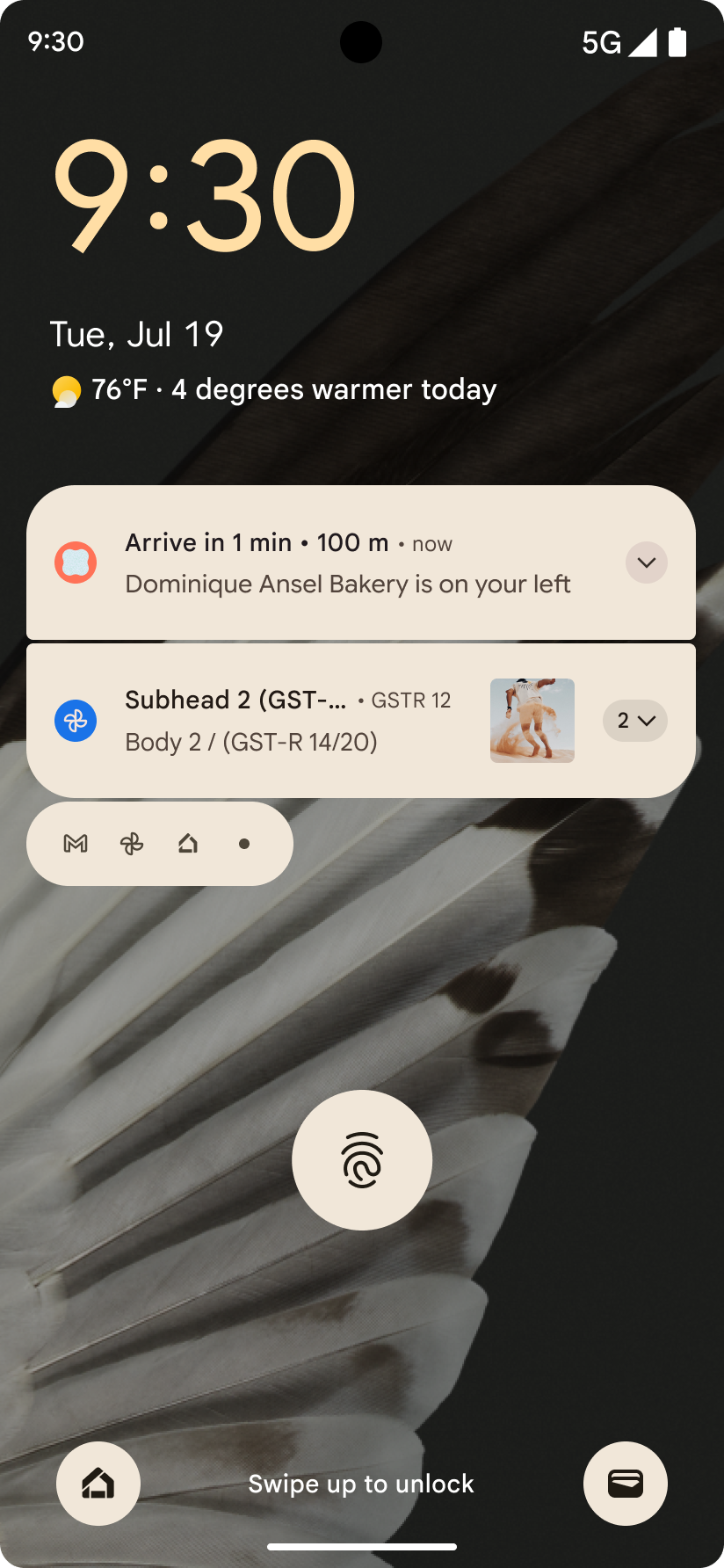
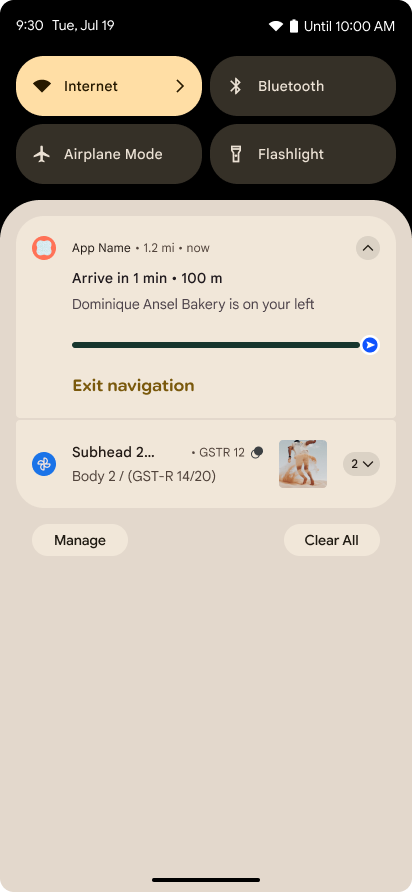
Thông tin cập nhật về tính năng xem trước thao tác quay lại
Android 16 bổ sung các API mới để giúp bạn bật ảnh động xem trước thao tác quay lại của hệ thống trong tính năng điều hướng bằng cử chỉ, chẳng hạn như ảnh động quay lại màn hình chính. Việc đăng ký onBackInvokedCallback bằng PRIORITY_SYSTEM_NAVIGATION_OBSERVER mới cho phép ứng dụng của bạn nhận lệnh gọi onBackInvoked thông thường bất cứ khi nào hệ thống xử lý thao tác quay lại mà không ảnh hưởng đến luồng thao tác quay lại thông thường.
Android 16 cũng thêm finishAndRemoveTaskCallback() và moveTaskToBackCallback. Bằng cách đăng ký các lệnh gọi lại này với OnBackInvokedDispatcher, hệ thống có thể kích hoạt các hành vi cụ thể và phát ảnh động tương ứng trước khi thao tác vuốt ngược được gọi.
Phản hồi xúc giác phong phú hơn
Android đã hiển thị quyền kiểm soát đối với bộ truyền động xúc giác kể từ khi ra mắt.
Android 11 đã hỗ trợ thêm các hiệu ứng xúc giác phức tạp hơn mà các bộ truyền động nâng cao hơn có thể hỗ trợ thông qua VibrationEffect.Compositions của các nguyên hàm ngữ nghĩa do thiết bị xác định.
Android 16 thêm API xúc giác cho phép các ứng dụng xác định độ lớn và đường cong tần số của hiệu ứng xúc giác trong khi loại bỏ sự khác biệt giữa các chức năng của thiết bị.
Năng suất và công cụ dành cho nhà phát triển
Mặc dù hầu hết công việc của chúng tôi nhằm cải thiện hiệu suất của bạn đều tập trung vào các công cụ như Android Studio, Jetpack Compose và các thư viện Android Jetpack, nhưng chúng tôi luôn tìm cách giúp bạn hiện thực hoá ý tưởng của mình trên nền tảng này.
Xử lý nội dung cho hình nền động
In Android 16, the live wallpaper framework is gaining a new content API to
address the challenges of dynamic, user-driven wallpapers. Currently, live
wallpapers incorporating user-provided content require complex, service-specific
implementations. Android 16 introduces
WallpaperDescription and
WallpaperInstance. WallpaperDescription lets you
identify distinct instances of a live wallpaper from the same service. For
example, a wallpaper that has instances on both the home screen and on the lock
screen may have unique content in both places. The wallpaper picker and
WallpaperManager use this metadata to better present
wallpapers to users, streamlining the process for you to create diverse and
personalized live wallpaper experiences.
Hiệu suất và pin
Android 16 giới thiệu các API giúp thu thập thông tin chi tiết về ứng dụng của bạn.
Lập hồ sơ do hệ thống kích hoạt
ProfilingManager được thêm vào Android 15, cho phép các ứng dụng yêu cầu thu thập dữ liệu phân tích tài nguyên bằng Perfetto trên các thiết bị công khai trong trường hợp thực tế.
Tuy nhiên, vì quá trình phân tích tài nguyên này phải bắt đầu từ ứng dụng, nên các luồng quan trọng như khởi động hoặc lỗi ANR sẽ khó hoặc không thể được ứng dụng ghi lại.
Để giúp giải quyết vấn đề này, Android 16 giới thiệu tính năng phân tích tài nguyên do hệ thống kích hoạt cho ProfilingManager. Các ứng dụng có thể đăng ký quan tâm đến việc nhận dấu vết cho một số trình kích hoạt nhất định, chẳng hạn như khởi động nguội reportFullyDrawn hoặc ANR, sau đó hệ thống sẽ bắt đầu và dừng dấu vết thay mặt cho ứng dụng. Sau khi quá trình theo dõi hoàn tất, kết quả sẽ được phân phối đến thư mục dữ liệu của ứng dụng.
Thành phần khởi động trong ApplicationStartInfo
ApplicationStartInfo được thêm vào Android 15, cho phép ứng dụng xem lý do khởi động quy trình, loại khởi động, thời gian khởi động, điều tiết và các dữ liệu chẩn đoán hữu ích khác. Android 16 thêm getStartComponent() để phân biệt loại thành phần nào đã kích hoạt quá trình khởi động. Điều này có thể hữu ích cho việc tối ưu hoá luồng khởi động của ứng dụng.
Khả năng tự xem xét công việc hiệu quả hơn
The JobScheduler#getPendingJobReason() API returns a reason why a job
might be pending. However, a job might be pending for multiple reasons.
In Android 16, we are introducing a new API
JobScheduler#getPendingJobReasons(int jobId), which returns multiple
reasons why a job is pending, due to both explicit constraints set by the
developer and implicit constraints set by the system.
We're also introducing
JobScheduler#getPendingJobReasonsHistory(int jobId), which returns a list
of the most recent constraint changes.
We recommend using the API to help you debug why your jobs may not be executing, especially if you're seeing reduced success rates of certain tasks or have bugs around latency of certain job completion. For example, updating widgets in the background failed to occur or prefetch job failed to be called prior to app start.
This can also better help you understand if certain jobs are not completing due to system defined constraints versus explicitly set constraints.
Tốc độ làm mới thích ứng
Tốc độ làm mới thích ứng (ARR), được giới thiệu trong Android 15, cho phép tốc độ làm mới màn hình trên phần cứng được hỗ trợ để thích ứng với tốc độ khung hình nội dung bằng cách sử dụng các bước VSync riêng biệt. Điều này giúp giảm mức tiêu thụ điện năng trong khi không cần phải chuyển đổi chế độ có thể gây ra hiện tượng giật.
Android 16 giới thiệu hasArrSupport() và getSuggestedFrameRate(int) trong khi khôi phục getSupportedRefreshRates() để giúp ứng dụng của bạn dễ dàng tận dụng ARR hơn. RecyclerView
1.4 hỗ trợ ARR nội bộ khi định vị từ một thao tác hất hoặc
cuộn mượt mà. Chúng tôi đang tiếp tục nỗ lực để thêm tính năng hỗ trợ
ARR vào nhiều thư viện Jetpack hơn. Bài viết về tốc độ khung hình này đề cập đến nhiều API mà bạn có thể sử dụng để đặt tốc độ khung hình để ứng dụng của bạn có thể trực tiếp sử dụng ARR.
Headroom API trong ADPF
The SystemHealthManager introduces the
getCpuHeadroom and
getGpuHeadroom APIs, designed to provide games and
resource-intensive apps with estimates of available CPU and GPU resources. These
methods offer a way for you to gauge how your app or game can best improve
system health, particularly when used in conjunction with other Android Dynamic
Performance Framework (ADPF) APIs that detect thermal
throttling.
By using CpuHeadroomParams and
GpuHeadroomParams on supported devices, you can
customize the time window used to compute the headroom and select between
average or minimum resource availability. This can help you reduce your CPU or
GPU resource usage accordingly, leading to better user experiences and improved
battery life.
Hỗ trợ tiếp cận
Android 16 bổ sung các API và tính năng hỗ trợ tiếp cận mới có thể giúp bạn đưa ứng dụng của mình đến với mọi người dùng.
API hỗ trợ tiếp cận được cải thiện
Android 16 adds additional APIs to enhance UI semantics that help improve consistency for users that rely on accessibility services, such as TalkBack.
Outline text for maximum text contrast
Users with low vision often have reduced contrast sensitivity, making it challenging to distinguish objects from their backgrounds. To help these users, Android 16 introduces outline text, replacing high contrast text, which draws a larger contrasting area around text to greatly improve legibility.
Android 16 contains new AccessibilityManager APIs to let
your apps check or register a listener to
see if this mode is enabled. This is primarily for UI Toolkits like Compose to
offer a similar visual experience. If you maintain a UI Toolkit library or your
app performs custom text rendering that bypasses the
android.text.Layout class then you can use this to know
when outline text is enabled.
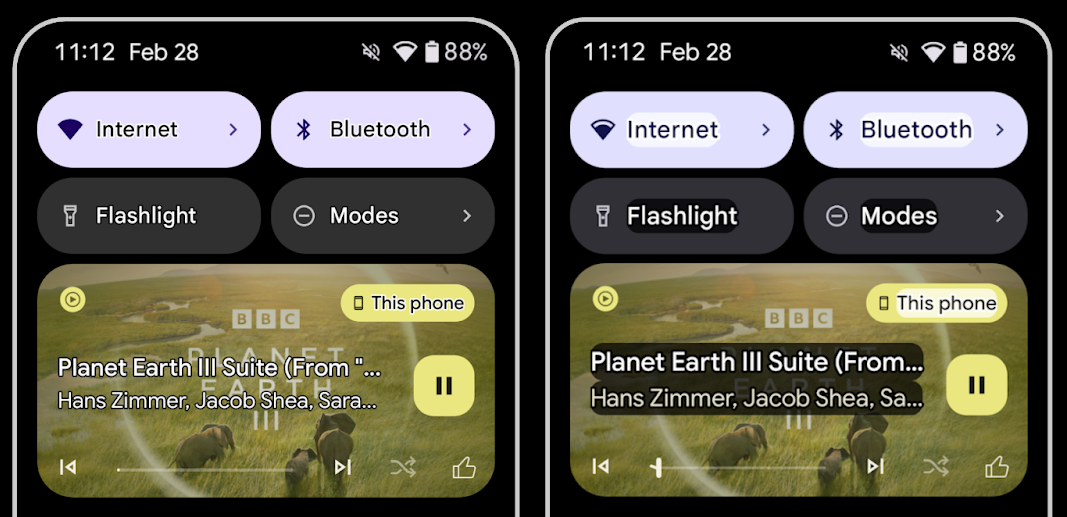
Duration added to TtsSpan
Android 16 extends TtsSpan with a TYPE_DURATION,
consisting of ARG_HOURS, ARG_MINUTES,
and ARG_SECONDS. This lets you directly annotate time
duration, ensuring accurate and consistent text-to-speech output with services
like TalkBack.
Support elements with multiple labels
Android currently allows UI elements to derive their accessibility label from
another, and now offers the ability for multiple labels to be associated, a
common scenario in web content. By introducing a list-based API within
AccessibilityNodeInfo, Android can directly support these
multi-label relationships. As part of this change, we've deprecated
AccessibilityNodeInfo#setLabeledBy and
#getLabeledBy in favor of
#addLabeledBy, #removeLabeledBy, and
#getLabeledByList.
Improved support for expandable elements
Android 16 adds accessibility APIs that allow you to convey the expanded or
collapsed state of interactive elements, such as menus and expandable lists. By
setting the expanded state using setExpandedState and
dispatching TYPE_WINDOW_CONTENT_CHANGED AccessibilityEvents
with a CONTENT_CHANGE_TYPE_EXPANDED content change type,
you can ensure that screen readers like TalkBack announce
state changes, providing a more intuitive and inclusive user experience.
Indeterminate ProgressBars
Android 16 adds RANGE_TYPE_INDETERMINATE, giving a way for
you to expose RangeInfo for both determinate and
indeterminate ProgressBar widgets, allowing services like
TalkBack to more consistently provide feedback for progress
indicators.
Tri-state CheckBox
The new AccessibilityNodeInfo
getChecked and setChecked(int)
methods in Android 16 now support a "partially checked" state in addition to
"checked" and "unchecked." This replaces the deprecated boolean
isChecked and setChecked(boolean).
Supplemental descriptions
When an accessibility service describes a ViewGroup, it
combines content labels from its child views. If you provide a
contentDescription for the ViewGroup, accessibility services assume you are
also overriding the description of non-focusable child views. This can be
problematic if you want to label things like a drop-down (for example, "Font
Family") while preserving the current selection for accessibility (for example,
"Roboto"). Android 16 adds setSupplementalDescription so
you can provide text that provides information about a ViewGroup without
overriding information from its children.
Required form fields
Android 16 adds setFieldRequired to
AccessibilityNodeInfo so apps can tell an accessibility
service that input to a form field is required. This is an important scenario
for users filling out many types of forms, even things as simple as a required
terms and conditions checkbox, helping users to consistently identify and
quickly navigate between required fields.
Điện thoại làm nguồn đầu vào micrô cho cuộc gọi thoại bằng thiết bị trợ thính LEA
Android 16 bổ sung tính năng cho phép người dùng thiết bị trợ thính LE Audio chuyển đổi giữa micrô tích hợp trên thiết bị trợ thính và micrô trên điện thoại để thực hiện cuộc gọi thoại. Điều này có thể hữu ích trong môi trường ồn ào hoặc các trường hợp khác mà micrô của thiết bị trợ thính có thể hoạt động kém.
Các nút điều chỉnh âm lượng môi trường xung quanh cho thiết bị trợ thính LEA
Android 16 bổ sung khả năng cho phép người dùng thiết bị trợ thính LE Audio điều chỉnh âm lượng của âm thanh môi trường xung quanh do micrô của thiết bị trợ thính thu được. Điều này có thể hữu ích trong trường hợp tạp âm quá lớn hoặc quá nhỏ.
Camera
Android 16 tăng cường hỗ trợ cho người dùng camera chuyên nghiệp, cho phép tự động phơi sáng kết hợp cùng với chế độ điều chỉnh nhiệt độ màu và sắc thái chính xác. Chỉ báo chế độ ban đêm mới giúp ứng dụng của bạn biết thời điểm chuyển đổi sang và từ phiên máy ảnh ở chế độ ban đêm. Các thao tác Intent mới giúp bạn dễ dàng chụp ảnh động hơn, đồng thời chúng tôi sẽ tiếp tục cải thiện hình ảnh UltraHDR bằng cách hỗ trợ mã hoá HEIC và các thông số mới theo tiêu chuẩn dự thảo ISO 21496-1.
Chế độ tự động phơi sáng kết hợp
Android 16 thêm các chế độ tự động phơi sáng kết hợp mới vào Camera2, cho phép bạn kiểm soát các khía cạnh cụ thể của chế độ phơi sáng theo cách thủ công, đồng thời để thuật toán tự động phơi sáng (AE) xử lý phần còn lại. Bạn có thể kiểm soát ISO + AE và thời gian phơi sáng + AE, mang lại tính linh hoạt cao hơn so với phương pháp hiện tại, trong đó bạn có toàn quyền kiểm soát thủ công hoặc hoàn toàn dựa vào chế độ tự động phơi sáng.
fun setISOPriority() {
// ... (Your existing code before the snippet) ...
val availablePriorityModes = mStaticInfo.characteristics.get(
CameraCharacteristics.CONTROL_AE_AVAILABLE_PRIORITY_MODES
)
// ... (Your existing code between the snippets) ...
// Turn on AE mode to set priority mode
reqBuilder.set(
CaptureRequest.CONTROL_AE_MODE,
CameraMetadata.CONTROL_AE_MODE_ON
)
reqBuilder.set(
CaptureRequest.CONTROL_AE_PRIORITY_MODE,
CameraMetadata.CONTROL_AE_PRIORITY_MODE_SENSOR_SENSITIVITY_PRIORITY
)
reqBuilder.set(
CaptureRequest.SENSOR_SENSITIVITY,
TEST_SENSITIVITY_VALUE
)
val request: CaptureRequest = reqBuilder.build()
// ... (Your existing code after the snippet) ...
}
Điều chỉnh chính xác nhiệt độ màu và sắc độ
Android 16 adds camera support for fine color temperature and tint adjustments
to better support professional video recording applications. In previous Android
versions, you could control white balance settings through
CONTROL_AWB_MODE, which contains options limited to a
preset list, such as Incandescent,
Cloudy, and Twilight. The
COLOR_CORRECTION_MODE_CCT enables the use of
COLOR_CORRECTION_COLOR_TEMPERATURE and
COLOR_CORRECTION_COLOR_TINT for precise adjustments of
white balance based on the correlated color temperature.
fun setCCT() {
// ... (Your existing code before this point) ...
val colorTemperatureRange: Range<Int> =
mStaticInfo.characteristics[CameraCharacteristics.COLOR_CORRECTION_COLOR_TEMPERATURE_RANGE]
// Set to manual mode to enable CCT mode
reqBuilder[CaptureRequest.CONTROL_AWB_MODE] = CameraMetadata.CONTROL_AWB_MODE_OFF
reqBuilder[CaptureRequest.COLOR_CORRECTION_MODE] = CameraMetadata.COLOR_CORRECTION_MODE_CCT
reqBuilder[CaptureRequest.COLOR_CORRECTION_COLOR_TEMPERATURE] = 5000
reqBuilder[CaptureRequest.COLOR_CORRECTION_COLOR_TINT] = 30
val request: CaptureRequest = reqBuilder.build()
// ... (Your existing code after this point) ...
}
The following examples show how a photo would look after applying different color temperature and tint adjustments:
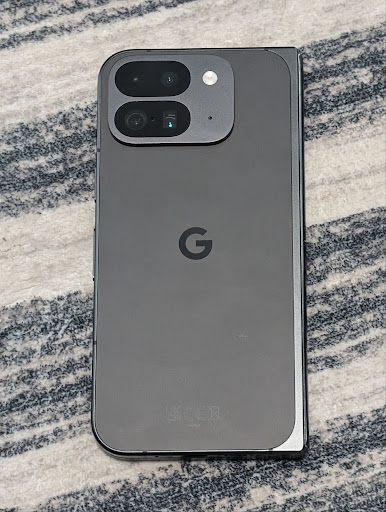
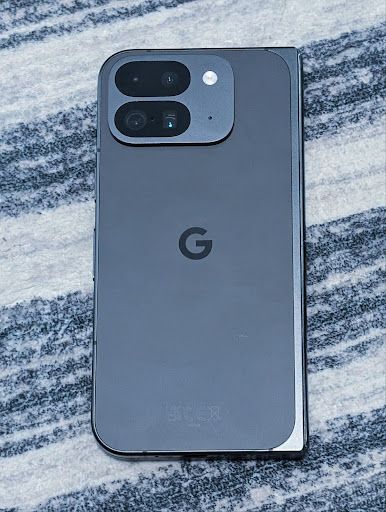
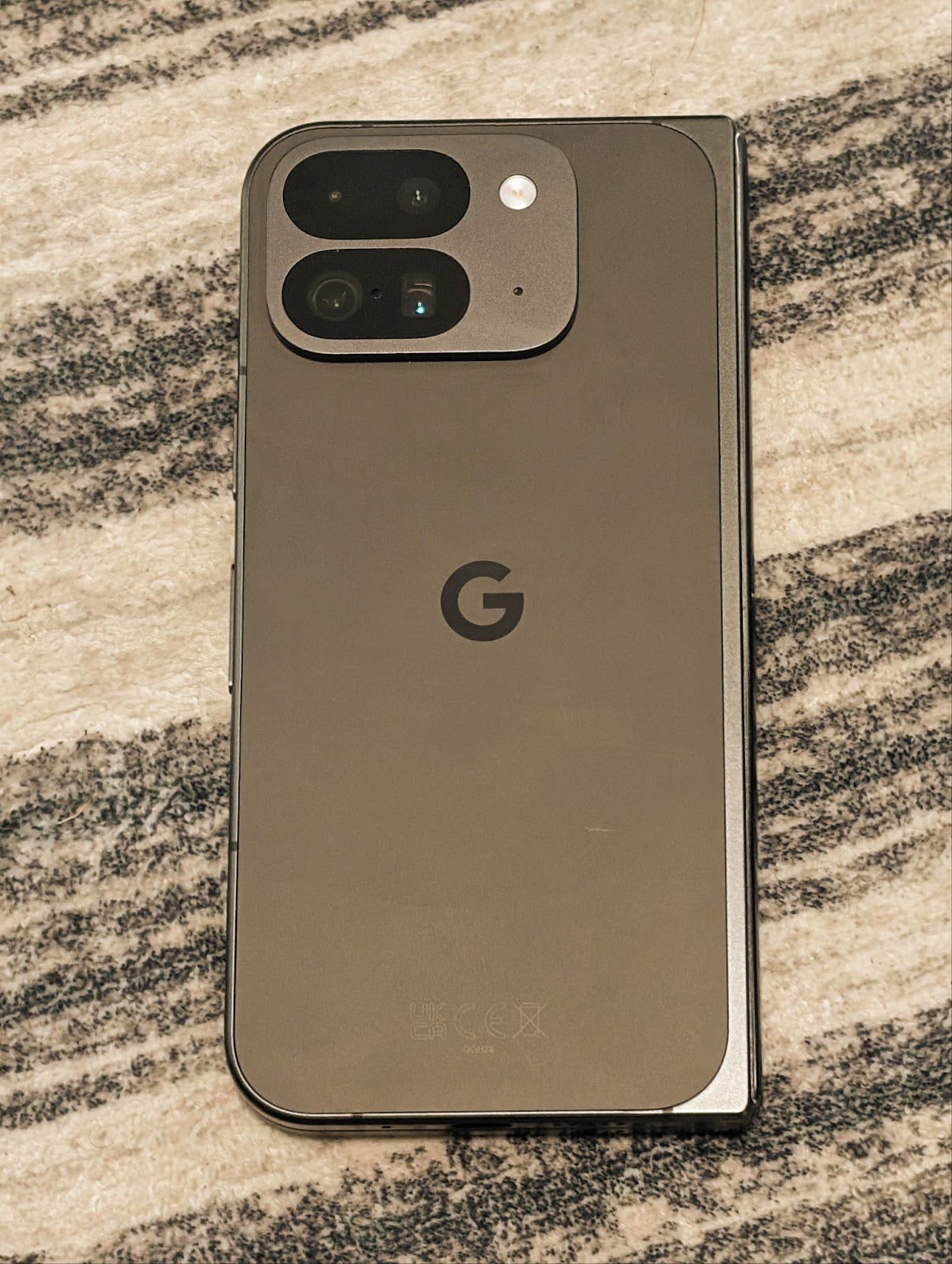

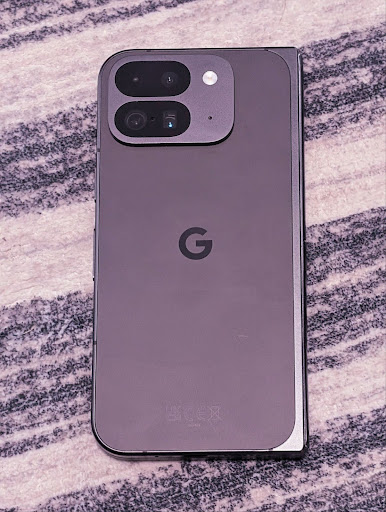
Tính năng phát hiện cảnh ở chế độ ban đêm của camera
Để giúp ứng dụng của bạn biết thời điểm chuyển sang và thoát khỏi phiên máy ảnh ở chế độ ban đêm, Android 16 sẽ thêm EXTENSION_NIGHT_MODE_INDICATOR. Nếu được hỗ trợ, bạn có thể sử dụng tính năng này trong CaptureResult trong Camera2.
Đây là API mà chúng tôi đã đề cập ngắn gọn trong bài đăng trên blog Cách Instagram giúp người dùng chụp những bức ảnh tuyệt đẹp trong điều kiện thiếu sáng. Bài đăng đó là một hướng dẫn thực tế về cách triển khai chế độ ban đêm cùng với một nghiên cứu điển hình liên kết ảnh chất lượng cao hơn ở chế độ ban đêm trong ứng dụng với việc tăng số lượng ảnh được chia sẻ từ máy ảnh trong ứng dụng.
Thao tác theo ý định chụp ảnh chuyển động
Android 16 adds standard Intent actions —
ACTION_MOTION_PHOTO_CAPTURE, and
ACTION_MOTION_PHOTO_CAPTURE_SECURE — which request that
the camera application capture a motion photo and return
it.
You must either pass an extra EXTRA_OUTPUT to control
where the image will be written, or a Uri through
Intent.setClipData(ClipData). If you don't set a
ClipData, it will be copied there for you when calling
Context.startActivity(Intent).
Các tính năng nâng cao hình ảnh Ultra HDR
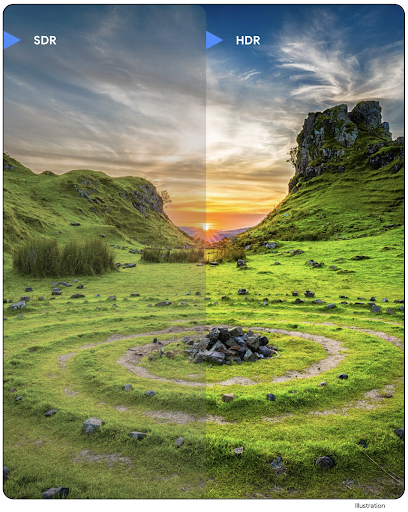
Android 16 continues our work to deliver dazzling image quality with UltraHDR
images. It adds support for UltraHDR images in the HEIC file
format. These images will get ImageFormat type
HEIC_ULTRAHDR and will contain an embedded gainmap similar
to the existing UltraHDR JPEG format. We're working on AVIF support for UltraHDR
as well, so stay tuned.
In addition, Android 16 implements additional parameters in UltraHDR from the ISO 21496-1 draft standard, including the ability to get and set the colorspace that gainmap math should be applied in, as well as support for HDR encoded base images with SDR gainmaps.
Đồ hoạ
Android 16 có các điểm cải tiến mới nhất về đồ hoạ, chẳng hạn như hiệu ứng đồ hoạ tuỳ chỉnh bằng AGSL.
Hiệu ứng đồ hoạ tuỳ chỉnh bằng AGSL
Android 16 thêm RuntimeColorFilter và RuntimeXfermode, cho phép bạn tạo các hiệu ứng phức tạp như Ngưỡng, Nâu đỏ và Độ bão hoà màu sắc và áp dụng các hiệu ứng đó cho các lệnh gọi vẽ. Kể từ Android 13, bạn có thể sử dụng AGSL để tạo RuntimeShaders tuỳ chỉnh mở rộng Shader. API mới phản ánh điều này, thêm một RuntimeColorFilter dựa trên AGSL mở rộng ColorFilter và hiệu ứng Xfermode cho phép bạn triển khai tính năng kết hợp và pha trộn tuỳ chỉnh dựa trên AGSL giữa các pixel nguồn và đích.
private val thresholdEffectString = """
uniform half threshold;
half4 main(half4 c) {
half luminosity = dot(c.rgb, half3(0.2126, 0.7152, 0.0722));
half bw = step(threshold, luminosity);
return bw.xxx1 * c.a;
}"""
fun setCustomColorFilter(paint: Paint) {
val filter = RuntimeColorFilter(thresholdEffectString)
filter.setFloatUniform(0.5);
paint.colorFilter = filter
}
Khả năng kết nối
Android 16 cập nhật nền tảng để cho phép ứng dụng của bạn sử dụng những tiến bộ mới nhất về công nghệ truyền thông và không dây.
Đo khoảng cách với tính năng bảo mật nâng cao
Android 16 adds support for robust security features in Wi-Fi location on supported devices with Wi-Fi 6's 802.11az, allowing apps to combine the higher accuracy, greater scalability, and dynamic scheduling of the protocol with security enhancements including AES-256-based encryption and protection against MITM attacks. This allows it to be used more safely in proximity use cases, such as unlocking a laptop or a vehicle door. 802.11az is integrated with the Wi-Fi 6 standard, leveraging its infrastructure and capabilities for wider adoption and easier deployment.
API đo khoảng cách chung
Android 16 includes the new RangingManager, which provides
ways to determine the distance and angle on supported hardware between the local
device and a remote device. RangingManager supports the usage of a variety of
ranging technologies such as BLE channel sounding, BLE RSSI-based ranging, Ultra
Wideband, and Wi-Fi round trip time.
Sự hiện diện của thiết bị trong trình quản lý thiết bị đồng hành
Trong Android 16, các API mới sẽ được giới thiệu để liên kết dịch vụ ứng dụng đồng hành. Dịch vụ sẽ được liên kết khi BLE ở trong phạm vi và Bluetooth được kết nối, đồng thời dịch vụ sẽ bị huỷ liên kết khi BLE ở ngoài phạm vi hoặc Bluetooth bị ngắt kết nối. Ứng dụng sẽ nhận được lệnh gọi lại "onDevicePresenceEvent()" mới dựa trên nhiều DevicePresenceEvent.
Bạn có thể xem thêm thông tin chi tiết trong "startObservingDevicePresence(ObservingDevicePresenceRequest)".
Nội dung nghe nhìn
Android 16 có nhiều tính năng giúp cải thiện trải nghiệm nghe nhìn.
Cải tiến công cụ chọn ảnh
Công cụ chọn ảnh cung cấp cho người dùng một cách tích hợp an toàn để cấp cho ứng dụng của bạn quyền truy cập vào những hình ảnh và video đã chọn từ cả bộ nhớ cục bộ và bộ nhớ trên đám mây, thay vì toàn bộ thư viện nội dung nghe nhìn của họ. Bằng cách kết hợp Các thành phần hệ thống mô-đun thông qua Bản cập nhật hệ thống của Google và Dịch vụ Google Play, tính năng này được hỗ trợ trở lại cho Android 4.4 (API cấp 19). Bạn chỉ cần vài dòng mã để tích hợp với thư viện Android Jetpack được liên kết.
Android 16 có các điểm cải tiến sau đây cho công cụ chọn ảnh:
- Trình chọn ảnh được nhúng: Các API mới cho phép ứng dụng nhúng trình chọn ảnh vào hệ phân cấp chế độ xem của ứng dụng. Điều này giúp người dùng cảm thấy như một phần tích hợp hơn của ứng dụng, trong khi vẫn tận dụng tính năng tách biệt quy trình cho phép người dùng chọn nội dung nghe nhìn mà không cần ứng dụng có quyền quá rộng. Để tối đa hoá khả năng tương thích trên các phiên bản nền tảng và đơn giản hoá quá trình tích hợp, bạn nên sử dụng thư viện Android Jetpack sắp ra mắt nếu muốn tích hợp công cụ chọn ảnh được nhúng.
- Tìm kiếm trên đám mây trong công cụ chọn ảnh: Các API mới cho phép tìm kiếm từ nhà cung cấp nội dung đa phương tiện trên đám mây cho công cụ chọn ảnh trên Android. Chức năng tìm kiếm trong bộ chọn ảnh sẽ sớm ra mắt.
Video chuyên nghiệp nâng cao
Android 16 ra mắt tính năng hỗ trợ bộ mã hoá và giải mã Video chuyên nghiệp nâng cao (APV). Bộ mã hoá và giải mã này được thiết kế để dùng cho việc quay video chất lượng cao và xử lý hậu kỳ ở cấp chuyên nghiệp.
Tiêu chuẩn bộ mã hoá và giải mã APV có các tính năng sau:
- Chất lượng video không bị mất dữ liệu (gần với chất lượng video thô)
- Mã hoá chỉ trong khung hình có độ phức tạp thấp và thông lượng cao (không có tính năng dự đoán miền pixel) để hỗ trợ tốt hơn quy trình chỉnh sửa
- Hỗ trợ phạm vi tốc độ bit cao lên đến vài Gbps cho nội dung có độ phân giải 2K, 4K và 8K, được bật bằng lược đồ mã hoá entropy nhẹ
- Sắp xếp khung hình cho nội dung sống động và để bật tính năng mã hoá và giải mã song song
- Hỗ trợ nhiều định dạng lấy mẫu màu sắc và độ sâu bit
- Hỗ trợ nhiều lần giải mã và mã hoá lại mà không làm giảm chất lượng hình ảnh nghiêm trọng
- Hỗ trợ video nhiều khung hình và video phụ như độ sâu, alpha và bản xem trước
- Hỗ trợ HDR10/10+ và siêu dữ liệu do người dùng xác định
Phương thức triển khai tham chiếu của APV được cung cấp thông qua dự án OpenAPV. Android 16 sẽ triển khai tính năng hỗ trợ cho Hồ sơ APV 422-10, cung cấp tính năng lấy mẫu màu YUV 422 cùng với tính năng mã hoá 10 bit và tốc độ bit mục tiêu lên đến 2 Gbps.
Quyền riêng tư
Android 16 có nhiều tính năng giúp nhà phát triển ứng dụng bảo vệ quyền riêng tư của người dùng.
Thông tin cập nhật về Health Connect
Health Connect adds ACTIVITY_INTENSITY, a data type defined according to World
Health Organization guidelines around moderate and vigorous activity. Each
record requires the start time, the end time, and whether the activity intensity
is moderate or vigorous.
Health Connect also contains updated APIs supporting medical records. This allows apps to read and write medical records in FHIR format with explicit user consent.
Hộp cát về quyền riêng tư trên Android
Android 16 tích hợp phiên bản mới nhất của Hộp cát về quyền riêng tư trên Android, một phần trong nỗ lực liên tục của chúng tôi nhằm phát triển các công nghệ giúp người dùng biết rằng quyền riêng tư của họ được bảo vệ. Trang web của chúng tôi có thêm thông tin về chương trình beta dành cho nhà phát triển của Hộp cát về quyền riêng tư trên Android để giúp bạn bắt đầu. Hãy xem Thời gian chạy SDK cho phép SDK chạy trong một môi trường thời gian chạy chuyên dụng tách biệt với ứng dụng mà chúng đang phân phát, cung cấp các biện pháp bảo vệ mạnh mẽ hơn cho việc thu thập và chia sẻ dữ liệu người dùng.
Bảo mật
Android 16 có các tính năng giúp bạn tăng cường tính bảo mật của ứng dụng và bảo vệ dữ liệu của ứng dụng.
Key sharing API
Android 16 bổ sung các API hỗ trợ chia sẻ quyền truy cập vào khoá Kho khoá Android với các ứng dụng khác. Lớp KeyStoreManager mới hỗ trợ cấp và thu hồi quyền truy cập vào khoá theo uid của ứng dụng, đồng thời bao gồm một API để các ứng dụng truy cập vào khoá dùng chung.
Kiểu dáng thiết bị
Android 16 hỗ trợ các ứng dụng của bạn để khai thác tối đa các kiểu dáng của Android.
Khung hình ảnh và âm thanh tiêu chuẩn cho TV
The new MediaQuality
package in Android 16 exposes
a set of standardized APIs for access to audio and picture profiles and
hardware-related settings. This allows streaming apps to query profiles and
apply them to media dynamically:
- Movies mastered with a wider dynamic range require greater color accuracy to see subtle details in shadows and adjust to ambient light, so a profile that prefers color accuracy over brightness may be appropriate.
- Live sporting events are often mastered with a narrow dynamic range, but are often watched in daylight, so a profile that preferences brightness over color accuracy can give better results.
- Fully interactive content wants minimal processing to reduce latency, and wants higher frame rates, which is why many TV's ship with a game profile.
The API allows apps to switch between profiles and users to enjoy tuning supported TVs to best suit their content.
Quốc tế hoá
Android 16 bổ sung các tính năng và chức năng bổ trợ cho trải nghiệm người dùng khi thiết bị được dùng bằng nhiều ngôn ngữ.
Văn bản dọc
Android 16 adds low-level support for rendering and measuring text vertically to
provide foundational vertical writing support for library developers. This is
particularly useful for languages like Japanese that commonly use vertical
writing systems. A new flag,
VERTICAL_TEXT_FLAG,
has been added to the Paint class. When
this flag is set using
Paint.setFlags, Paint's
text measurement APIs will report vertical advances instead of horizontal
advances, and Canvas will draw text
vertically.
val text = "「春は、曙。」"
Box(
Modifier.padding(innerPadding).background(Color.White).fillMaxSize().drawWithContent {
drawIntoCanvas { canvas ->
val paint = Paint().apply { textSize = 64.sp.toPx() }
// Draw text vertically
paint.flags = paint.flags or VERTICAL_TEXT_FLAG
val height = paint.measureText(text)
canvas.nativeCanvas.drawText(
text,
0,
text.length,
size.width / 2,
(size.height - height) / 2,
paint
)
}
}
) {}
Tuỳ chỉnh hệ thống đo lường
Giờ đây, người dùng có thể tuỳ chỉnh hệ thống đo lường theo lựa chọn ưu tiên theo khu vực trong phần Cài đặt. Lựa chọn ưu tiên của người dùng được đưa vào mã ngôn ngữ, vì vậy, bạn có thể đăng ký BroadcastReceiver trên ACTION_LOCALE_CHANGED để xử lý các thay đổi về cấu hình ngôn ngữ khi lựa chọn ưu tiên theo khu vực thay đổi.
Việc sử dụng trình định dạng có thể giúp phù hợp với trải nghiệm cục bộ. Ví dụ: "0,5 in" (inch) bằng tiếng Anh (Hoa Kỳ) là "12,7 mm" đối với người dùng đã đặt điện thoại thành tiếng Anh (Đan Mạch) hoặc người dùng sử dụng điện thoại bằng tiếng Anh (Hoa Kỳ) với hệ mét là hệ thống đo lường ưu tiên.
Để tìm các chế độ cài đặt này, hãy mở ứng dụng Cài đặt rồi chuyển đến Hệ thống > Ngôn ngữ và khu vực.

